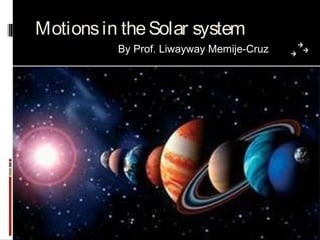
The 8 Planets in Our Solar System and Their Motions
- 1. THE SOLAR SYSTEM by Prof. Liwayway Memije-Cruz
- 5. Constellationshavebeen an important part of human society and folkloresincewe humanslived in caves and even before. Thefascinating scenariosthat weseein the night sky areso largeand so beautiful that wehavefelt avery strong urgeto attach importanceto them. Peoplethuscreate very interesting storiesand legendsin an attempt to explain theselarge"pictures" in thesky.
- 7. Ecliptic: thepath that thesun tracesout on thesphere
- 8. TheEarth in theCelestial Sphere
- 10. Earth’sMotion Rotation Revolution Rotation of theearth describesthespinning of theearth around its axis, resulting in the24 hour phenomenon of day and night over theearth. Revolution on the other hand describesthe movement of theearth around thesun over a period of oneyear, causing seasonsto occur.
- 11. Timeand Clocks
- 12. A Sidereal Day Theearth spins onceon itsaxis every 23 hours, 56 minutes(rounded to thenearest minute). Thetime to completeone completerotation is known asa sidereal day and isquite different from the traditional concept of a"day
- 13. A Solar Day For astronomers, theday actually beginswhen thesun crossesthe meridian. Wecan call this"high noon" ... an old cowboy phrasewhich means that thesun isat itshighest point in the day. You will soon seethat theclock rarely reads12:00 at thistime The rotation of theearth on itsaxis eventually forcesthesun to set in the west, riseagain in theeast, and move back to themeridian (high noon). This definesa solarday - high noon to high noon. Thefirst thing you haveto realizeisthat theearth spinsslightly morethan onefull rotation during a solar day.
- 14. 1. theplanetsin theSolar System orbit around theSun1. theplanetsin theSolar System orbit around theSun 2. orbitsarealmost perfect - circle: Sun isthecenter of the2. orbitsarealmost perfect - circle: Sun isthecenter of the circlecircle 3. someorbitsareoval shaped or “stretched out” circles–3. someorbitsareoval shaped or “stretched out” circles– ellipses: theSun isat the“focus” of theellipseellipses: theSun isat the“focus” of theellipse
- 15. Aphelion and PerihelionAphelion and Perihelion •Perihelion - theplace wheretheplanet isclosest to theSun. •Aphelion - when theplanet isfurthest away from the Sun. •“Aphelion" and "perihelion" comefrom the Greek language: "helios" mean sSun, "peri" means near, and "apo" meansaway from.
- 16. Theduration of asolar day variesthroughout theyear. That is, if you wereto measurethetimefrom high noon to thenext high noon, you would get adifferent valueevery day. Why? Kepler'sSecond Law tells usthat thespeed of theearth's revolution around thesun varies... moving fastest at perihelion and slowest at aphelion. Therotation rateof theearth, remains fixed At aphelion: solar day is fast At perihelion solar day is longer
- 17. Seasons occur due to Earth’sSeasons occur due to Earth’s revolutionrevolution
- 18. Motion of Stars • Somestars risedirectly east heading to theright, then crossthehigh southern sky, and eventually set directly west. • Other starsrisein thesoutheast and follow shorter, lower arcsacrossthe south beforesetting in thesouthwest. • And in thenorth, therearemany starsthat never riseor set at all; these “circumpolar stars” follow counter-clockwisecircles
- 21. Inner Planetsor Terrestrial Planets characterized by their dense, rocky composition few or no moons, and lack of ring systems composed largely of minerals with high melting pointssuch assilicatesto form the planets’ solid crustsand semi-liquid mantles, and metallic dust grainssuch asiron, which formstheir cores. threeof thefour inner planetshaveatmosphere. All haveimpact craters, and all but onepossesstectonic surfacefeatures, such asrift valleysand volcanoes.
- 23. TheOuter Planetsor Jovian Planets • Collectively makeup 99 percent of themassknown to orbit theSun. • Jupiter and Saturn aretruegiants, at 318 and 95 Earth masses, respectively, and composed largely of hydrogen and helium • Uranusand Neptuneareboth substantially smaller, being only 14 and 17 Earth masses, respectively. • Their atmospherescontain asmaller percentageof hydrogen and helium, and ahigher percentageof “ices”, such aswater, ammoniaand methane. For thisreason someastronomerssuggested that they belong in their own category, “Uranian planets” or “icegiants”. • All four of gasgiantsexhibit orbital debrisrings, although only thering system of Saturn iseasily observablefrom Earth. Theterm outer planet should not beconfused with superiorplanet, which designatesthose planetswhich lieoutsideEarth’sorbit (thusconsisting of theouter planets plusMars.
- 24. Inferior planets: Morning and evening stars Mercury and Venusare classified as inferior planet becausetheir orbitalsarefound insidetheorbit of theearth and seem closer to the sun Manifest both progradeand retrogrademotion
- 25. Superior Planets Mars. Jupiter, Saturn, Uranus and Neptune Exhibit their own revolution and motion from west to east (prograde motion) As they catches up by the Earth , they move in opposite direction which is from east to west (retrograde
- 26. Retrogradeand Prograde Retrogradeorbit: thesatellite(red) orbitsin the direction opposite to therotation of itsprimary (blue/black)
- 27. Aristotleand theEarth-Centered Universe Aristotle - one of thefamous Greek philosophers known for his ideathat the earth isthe center of the solar system.
- 28. Renaissanceand theHeliocentric Solar System • TheEarth revolves around thesun as proposed by Arstarchus of Samos •Copernican Revolution: Nicolaus Copernican proposed themathematical model of theheliocentric system which was supported by Johannes Kepler and Galileo Galilei
- 29. Motionsof theEarth and theMoon o cause theday and night o reason for seasons
- 30. SeasonsSeasons
- 31. • The Moon moves around the Earth in an approximately circular orbit, going once around us in approximately 27.3 days, or one sidereal period of revolution. • Each night, it moves about 13 degrees, or about 26 diameters, to the east.
- 32. Phasesof theMoon
- 33. Let us just enjoy the magic of the night sky…Let us just enjoy the magic of the night sky…
